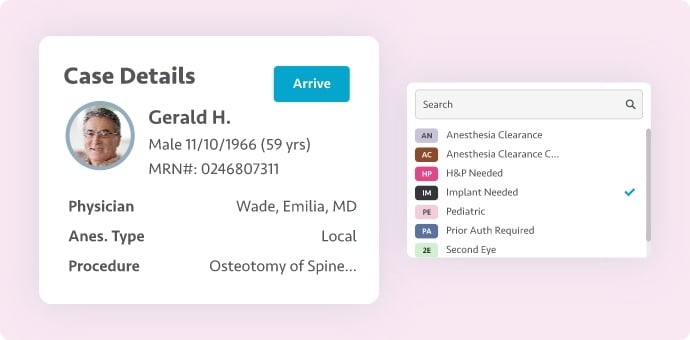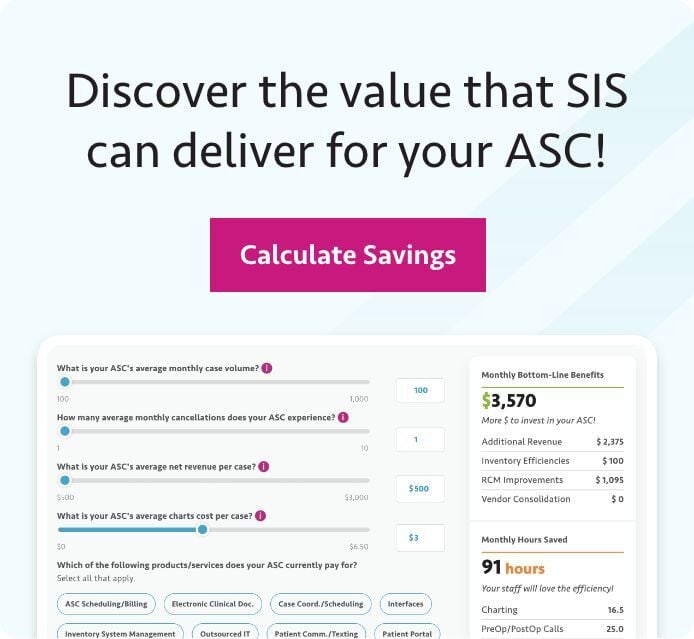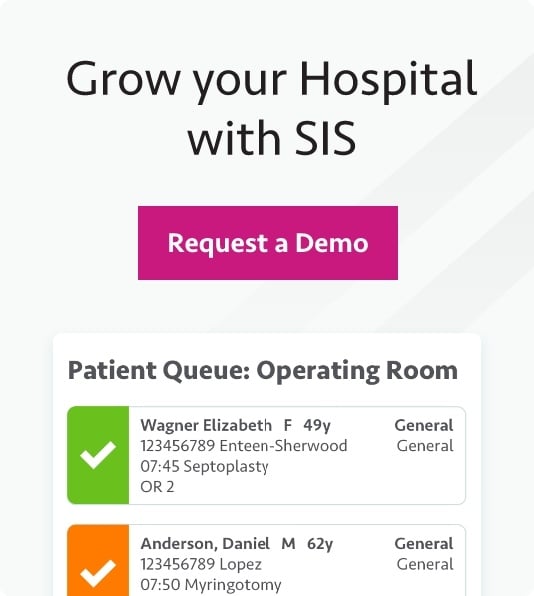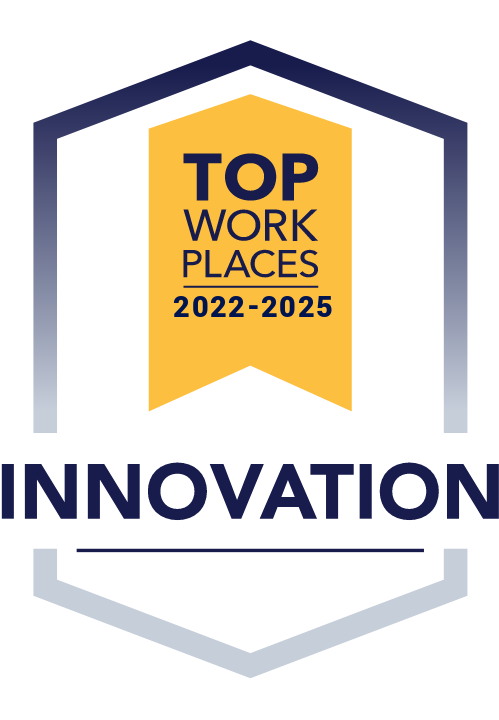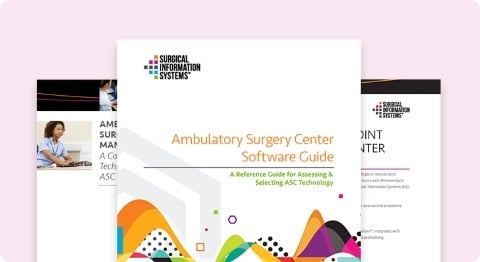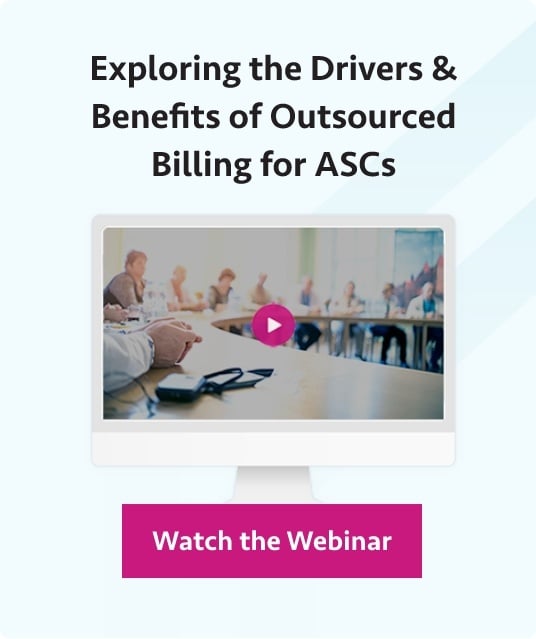Q&A with Ann Marie Thom, Senior Manager, Client Operations, for the Surgical Information Systems Revenue Cycle Services Team
I recently hosted a webinar on "Moving From In-House to Outsourced ASC Revenue Cycle Management." During the program, I covered topics including key steps for transitioning from in-house revenue cycle management (RCM) to an outsourced partner, setting clear workflows and communication plans, simulating processes to identify gaps, using key performance indicators (KPIs) to measure success, and strategies for maintaining transparency and a strong partnership.
The audience was engaged and asked many great questions during the Q&A portion of the program. Below are the highlights of those questions and responses, edited for readability. The webinar can be viewed on-demand.
Q: How long does transitioning from in-house to outsourced ASC revenue cycle management typically take?
On average, it can take anywhere from three to six months, or sometimes a little longer. It really depends on the complexity of your ASC and the readiness of both your internal team and your outsourcing partners.
Typically, planning and selecting a partner takes about one to two months. During that time, you're identifying goals and pain points, researching and evaluating vendors, doing due diligence, and signing contracts.
Next comes workflow mapping and data preparation, which can take another couple of weeks. System integration can sometimes take a little longer, since it involves integrations, training the vendor on your systems, workflows, and payers, and aligning claim submissions to ensure everything goes out correctly.
Overall, the timeline really varies depending on the fluidity of each part of the process.
Q: How difficult is it to change from one outsourced ASC RCM vendor to another?
This is a great question. Changing from one outsourced vendor to another can range from moderately to highly difficult, depending on several factors.
One major challenge is data access and ownership. Your current vendor might control key systems or data. For example, they may manage your lockbox, have access to billing software, or control payer portals. Transitioning that access can be complicated, especially if there's reluctance or delays in sharing historical accounts receivable or denial data.
Another important consideration is deciding whether the new vendor will take over your entire revenue cycle — including legacy AR (accounts receivable) — or if there will be a cut-off point. Clarifying that early is critical, because a lack of communication around those details often causes bottlenecks.
Also, look at your contractual obligations. Review termination clauses, notice periods, offboarding fees, data handover requirements, and whether transition assistance is included.
You also need to be mindful of "knowledge drain." The outgoing vendor — or even internal team members — might hold valuable insights about payer quirks, workflows, or prior denials. If that information isn't documented and handed off properly, it can be lost. Sometimes, outgoing vendors or internal staff can be less cooperative during the transition, which adds to the complexity.
Technology compatibility is another big factor. If your old vendor — or in-house team — was using different software or paper-based processes, you may need to update or integrate your systems to align with the new vendor. That includes your EMR, practice management system, and clearinghouse. Some of these transitions, especially porting with clearinghouses, can take weeks.
And don't forget about workflow disruption. Transitions can impact staff morale, especially if people feel displaced or uncertain about their roles. Some may even leave. So it's important to identify those risks early and work to minimize disruption.
Ultimately, the smoother and more clearly defined your handoff is, the better. Make sure roles, responsibilities, and workflows are well documented and communicated. That will help reduce confusion among your internal team and ensure the transition stays on track.
Q: How much visibility should I expect to have into my ASC's data and performance after outsourcing our revenue cycle management?
You should expect full visibility into your ASC's data and performance after outsourcing, not less. If you see less visibility, that's a red flag. Your outsourcing partner should offer full transparency, including real-time reporting as a standard part of their service.
One best practice is to understand how and when you will receive reporting. Know when your center's billing period closes, and ask: how soon after that will you get your reports? This is especially important if you need to present financials at board meetings. Don't assume the reports will be ready immediately after the billing period ends. They need time to compile and validate the data.
So, communicate your timelines clearly. For example, if you need reports within two or three working days after closing, let your vendor know that upfront. Set expectations early and clearly.
It's also a good idea to establish service-level agreements (SLAs) and include those in your contract. That way, everyone understands their responsibilities and timelines from the start.
In addition, schedule regular standing meetings. Especially during the transition period, don't assume everything is running smoothly. Schedule weekly or biweekly meetings to review data and discuss any issues. Over time, you can move to a monthly cadence, but there should always be a meeting after each month-end close to review KPIs. Whether through a dashboard or a reporting package, your vendor should provide a comprehensive summary.
Before onboarding, ask potential vendors for sample reports so you know what kind of data and detail you will receive. Make sure they're willing to share raw data, not just summaries. Summaries are helpful, but being able to drill down into the data to understand what's driving your performance is critical.
Q: What are common challenges you run into when helping ASCs make the switch to outsourced RCM?
Incomplete or disorganized information, especially when a center has been managing RCM in-house. A lot of institutional knowledge lives in people's heads rather than being documented. The in-house team knows their processes so well that they often haven't written anything down. But when you're transitioning to an outsourced model, it becomes critical to document that knowledge and communicate it clearly to your new partner.
Without clean and organized data, you're likely to see missing patient information, old or inaccurate balances, inconsistent coding, and delays in claims processing or denials. One way to address this is to run a data audit before the transition, then clean up your patient demographics, verify CPT codes, and confirm insurance eligibility.
Another frequent challenge is the lack of documented workflows. It is important to map out every part of your revenue cycle and make sure your outsourcing partner has access to those workflows. If they have existing processes on their side, those should be shared as well.
Unclear roles and communication paths also cause problems. If no one knows who is responsible for what, it can lead to delays, duplicate work, or finger-pointing. The fix here is to clearly define roles, responsibilities, and escalation paths. Include these in your standard operating procedures and SLAs. Assigning an internal transition lead as a main point of contact can also help keep things on track.
Another challenge is internal resistance. Ideally, transitions go smoothly, but in reality, some staff members may worry about job security or losing control over processes. That can lead to poor cooperation or withholding of information. To address this, be transparent about how outsourcing will impact the team. Reassure them that their roles — whether in eligibility, documentation, or elsewhere — are still critical to the organization's success.
Delayed system access is another big hurdle. If your new partner does not have timely access to the EMR, practice management system, or clearinghouse, onboarding will stall. The solution is early coordination. Get both your internal and vendor IT teams involved to ensure that access credentials are in place, tested, and working before going live. Don't wait until the transition day to find out something isn't working.
Finally, make sure you're aligned on definitions and expectations. Simple terms like "clean claim" or "timely filing" might mean different things to different people. Clarify these up front so everyone is on the same page about key metrics and what success looks like before the transition even begins.
Q: What do ASCs that see early success with outsourcing RCM usually do right during the transition?
A few things come to mind right away. First, mapping and documenting your current policies and procedures is critical. Your vendor needs to clearly understand how things are done in your center.
You should also assign strong individuals to manage the transition. Ideally, there's a main point of contact. Maybe it's the administrator, the business office manager, or both. Either way, make sure expectations and responsibilities are clearly mapped out.
Centers that do well typically have a clean audit process in place. They know who is responsible for checking that claims are being submitted correctly, coded accurately, and followed up on appropriately.
Another best practice is to do a soft launch. Give yourself time to test and validate the workflows before going fully live. You might have everything written out perfectly, but once you put it into action, you may discover issues. Soft launches help catch and fix those early.
Clear escalation paths are also important. Define who to contact and when, in case something needs urgent attention.
And do not underestimate the power of communication. It is vital to the success of your transition. Whether it's verbal or via email, set standards for how quickly you expect responses. I always tell my team to acknowledge emails, even if it's just to confirm receipt. Establish expectations on how and when communication will happen, especially during calls or updates.
Also, keep each other informed of internal changes. Staffing changes, schedule adjustments — anything that might impact revenue cycle operations — should be shared promptly with your outsourced team.
Lastly, set clear expectations up front about what you want to see in your reports. That helps your outsourcing partner understand your needs from the start and avoids delays in getting the right information.
In my experience, the ASCs that follow these practices tend to have the smoothest transitions. There may still be a few hiccups, but overall, the process is much more successful.




